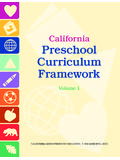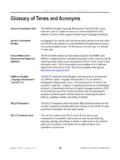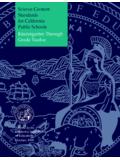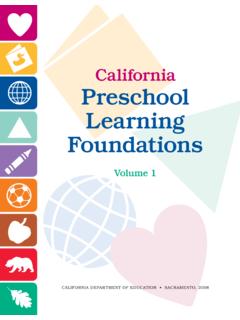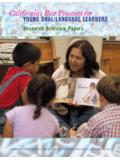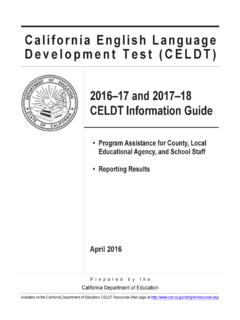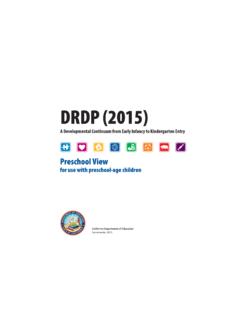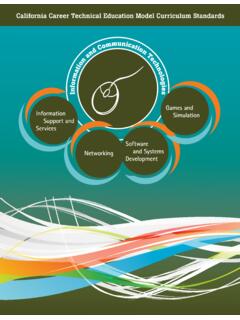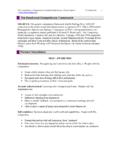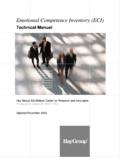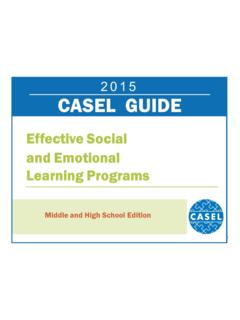Transcription of California Infant/Toddler Curriculum Framework
1 California Infant/Toddler Curriculum Framework California department of education Sacramento, 2012. California Infant/Toddler Curriculum Framework California department of education Sacramento, 2012. Publishing Information The California Infant/Toddler Curriculum Framework was developed by the California department of education /Child Development Division (CDE/CDD). The publication was edited by John McLean, working in cooperation with Tom Cole and Lisa Duerr, Consultants, Child Develop- ment Division. It was prepared for printing by the staff of CDE Press, with the cover and interior design created by Juan D. Sanchez. The document was published by the California department of education , 1430 N Street, Sacramento, CA 95814-5901. It was distributed under the provisions of the Library Distribution Act and Government Code Section 11096.
2 2012 by the California department of education All rights reserved ISBN: 978-0-8011-1723-7. Ordering Information Copies of this publication are available for purchase from the California department of education (CDE). For prices and ordering information, visit or call the CDE Press sales office at 1-800-995-4099. Notice The guidance in the California Infant/Toddler Curriculum Framework is not binding on local educational agencies or other entities. Except for statutes, regulations, and court decisions referenced herein, the docu- ment is exemplary, and compliance with it is not mandatory. (See Educa- tion Code Section ). Contents A Message from the State Superintendent of Public Instruction v Acknowledgments vi Chapter 1: Introduction to the Framework 1. California 's Infants and Toddlers 1.
3 Overarching Principles 4. Organization of the Infant/Toddler Curriculum Framework 9. Dual-Language Development and Learning in All Domains 10. Universal Design for Learning 11. Program Features That Support Effective Infant/Toddler Curriculum 12. The Infant/Toddler Learning Process: The Starting Point 12. Curriculum Planning 19. Reflections on Observation, Documentation, Assessment, and Planning 32. Implementation of a Plan 44. Endnotes 48. Bibliography 49. Chapter 2: The California Early Learning and Development System 53. Infant/Toddler Learning and Development Foundations 54. Infant/Toddler Curriculum Framework 55. Desired Results Assessment System Desired Results Developmental Profile (DRDP) 56. Program Guidelines and Other Resources 59. Professional Development 60.
4 In-Depth Understanding and Planning for Children's Integrated Learning 60. Bibliography 61. Chapter 3: Social Emotional Development 63. Guiding Principles 64. Summary of the Foundations 67. Environments and Materials 67. Interactions 69. Engaging Families 75. Questions for Reflection 76. Concluding Thoughts 77. Map of the Foundations 78. Teacher Resources 78. Endnotes 79. Bibliography 81. iii Chapter 4: Language Development 83. Guiding Principles 84. Summary of the Foundations 88. Environments and Materials 88. Interactions 89. Engaging Families 94. Questions for Reflection 95. Concluding Thoughts 95. Map of the Foundations 96. Teacher Resources 97. Endnotes 98. Bibliography 98. Chapter 5: Cognitive Development 101. Guiding Principles 102. Summary of the Foundations 106.
5 Environments and Materials 107. Interactions 110. Engaging Families 116. Questions for Reflection 117. Concluding Thoughts 118. Map of the Foundations 119. Teacher Resources 120. Endnotes 120. Bibliography 121. Chapter 6: Perceptual and Motor Development 123. Guiding Principles 127. Summary of the Foundations 130. Environments and Materials 130. Interactions 132. Engaging Families 138. Questions for Reflection 139. Concluding Thoughts 140. Map of the Foundations 141. Teacher Resources 142. Endnotes 143. Bibliography 145. Appendix: Resources for Teachers of Children with Disabilities or Other Special Needs 147. iv A Message from the State Superintendent of Public Instruction I. am pleased to present the California Attention is given to the importance of Infant/Toddler Curriculum Frame- responsive, individualized care that is work.
6 Infancy is a distinctive period grounded in children's secure relation- in a child's life that calls for unique ships with their parents and primary responses from adults. In the past caregivers. Seen as part of a compre- 20 years, research has told us much hensive system, the Infant/Toddler about brain development, how children Curriculum Framework supports effec- learn, and how best to facilitate that tive planning and the ongoing cycle learning. We now know that from the of observing, documenting, reflecting, moment of birth, infants are ready to and implementing appropriate curricu- learn and are able to absorb informa- lum. tion rapidly to understand the world The California Infant/Toddler Cur- around them. riculum Framework speaks to infant /. Created as a companion publication toddler care professionals, program to the California Infant/Toddler Learn- directors, faculty of higher education , ing and Development Foundations, this and families.
7 By understanding the Framework supports caregivers as they development and learning process of strive to make teaching responsive and infants and toddlers, early childhood meaningful for infants and toddlers. professionals can effectively support It presents strategies and informa- early learning, program directors can tion to enrich learning and develop- create high-quality learning environ- ment opportunities and provides a ments, and faculty can better prepare structure that Infant/Toddler providers tomorrow's infant care teachers. Fam- and administrators can use to make ily members can better share their informed decisions as they plan learn- knowledge of their children and work ing environments and experiences for as partners with caregivers to support our youngest children.
8 Like the infant / infants' and toddlers' active explora- toddler foundations, the Framework tion and learning. I hope this resource is based on current research on how helps every adult understand how infants and toddlers learn and develop to create a strong foundation for the in four domains: (1) social emotional, child's well-being and long-term (2) language, (3) cognitive, and (4) per- success. ceptual and motor development. The Framework emphasizes both the central role of the family in a young child's learning and development and Tom Torlakson the diversity of California 's families. State Superintendent of Public Instruction v Acknowledgments T. he development of the Califor- Chapter 3: Social Emotional nia Infant/Toddler Curriculum Development Framework involved many Min Chen, WestEd people.
9 We gratefully acknowledge Deborah Greenwald, WestEd each of the following contributors to Janis Keyser, Cabrillo College this publication. Peter Mangione, WestEd Margie Perez-Sesser, Consultant Project Leader Charlotte Tilson, WestEd Peter Mangione, WestEd Cathy Tsao, WestEd Elita Amini Virmani, WestEd Panel of Experts Chapter 4: Language Development Marc Bornstein, National Institute of Min Chen, WestEd Health and Human Development Deborah Greenwald, WestEd Vera Gutierrez-Clellen, San Diego State Peter Mangione, WestEd University Margie Perez-Sesser, Consultant Jeree Pawl, Clinical Psychologist Charlotte Tilson, WestEd Ross Thompson, University of Califor- Cathy Tsao, WestEd nia, Davis Elita Amini Virmani, WestEd Marlene Zepeda, California State Univer- sity, Los Angeles Chapter 5: Cognitive Development Min Chen, WestEd Writers Deborah Greenwald, WestEd Mary Jane Maguire-Fong, American Chapter 1.
10 Introduction to the River College Framework Peter Mangione, WestEd J. Ronald Lally, WestEd Margie Perez-Sesser, Consultant Mary Jane Maguire-Fong, American Charlotte Tilson, WestEd River College Cathy Tsao, WestEd Peter Mangione, WestEd Elita Amini Virmani, WestEd Chapter 2: The California Early Chapter 6: Perceptual and Motor Learning and Development System Development Jenna Bilmes, WestEd Min Chen, WestEd Melinda Brookshire, WestEd Deborah Greenwald, WestEd Jan Davis, WestEd Peter Mangione, WestEd Peter Mangione, WestEd Alice Nakahata, Consultant Charlotte Tilson, WestEd Margie Perez-Sesser, Consultant vi Charlotte Tilson, WestEd Focus Groups (Public Input). Cathy Tsao, WestEd Thank you to the focus-group par- Elita Amini Virmani, WestEd ticipants who offered valuable feedback Appendix: Resources for Teachers of and suggestions.
